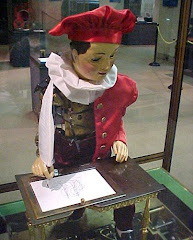How I Drew One of My Pictures: *
or, The Authorship of Generative Art
Adrian Ward BSc & Geoff Cox MA(RCA)
Abstract
The concept of value is traditionally bestowed on a work of art when it is seen to be unique and irreproducible, thereby granting it authenticity. Think of a famous painting: only the original canvas commands genuinely high prices.
Digital artwork is not valued in the same way. It can be copied infinitely and there is therefore a corresponding crisis of value. It has been argued that under these conditions of the dematerialised artwork, it is process that becomes valued. In this way, the process of creation and creativity is valued in place of authenticity, undermining conventional notions of authorship.
It is possible to correlate many of these creative processes into instructions. However, to give precise instructions on the construction of a creative work is a complex, authentic and intricate process equivalent to conventional creative work (and is therefore not simply a question of 'the death of the author'). This paper argues that to create 'generative' systems is a rigorous and intricate procedure. Moreover, the output from generative systems should not be valued simply as an endless, infinite series of resources but as a system. To have a machine write poetry for ten years would not generate creative music, but the process of getting the machine to do so would certainly register an advanced form of creativity.
When a programmer develops a generative system, they are engaged in a creative act. Programming is no less an artform than painting is a technical process. By analogy, the mathematical value pi can be approximated as 3.14159265, but a more thorough and accurate version can be stored as the formula used to calculate it. In the same way, it is more complete to express creativity formulated as code, which can then be executed to produce the results we desire. Rather like using Leibnitz's set of symbols to represent a mathematical formula, artists can now choose to represent creativity as computer programs (Harold Cohen's Aaron, a computer program that creates drawings is a case in point).
By programming computers to undertake creative instructions, this paper will argue that more accurate and expansive traces of creativity are being developed that suitably merge artistic subjectivity with technical form. It is no longer necessary or even desirable to be able to render art as a final tangible medium, but instead it is more important to program computers to be creative by proxy.
Paper.
Sunday, 5 October 2008
Subscribe to:
Post Comments (Atom)




No comments:
Post a Comment